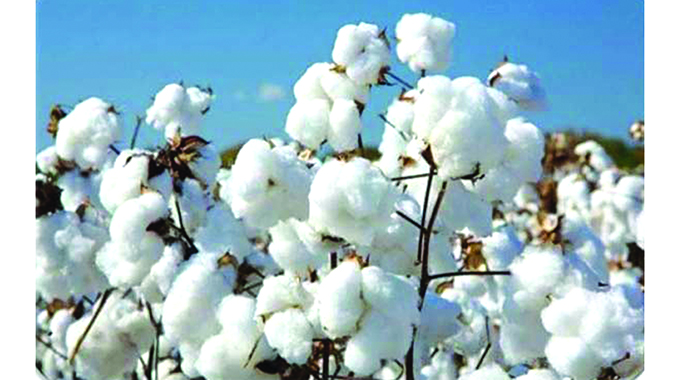Editorial Comment: Industry must capitalise on cotton harvests

The dramatic expansion in cotton harvests since the extension of the Pfumvudza-Intwasa programme to the Presidential Cotton Inputs Scheme with Cottco recording a rise from 155 000 households to 500 000 is not just creating rural wealth, but is also providing assured flows of raw materials that our industrialists and investors need to start using.
Cotton used to be a major crop. Production declined for all sorts of reasons including undercapitalisation, rampant side marketing as some dubious companies joined the herd after Cottco lost its monopoly, and a shortage of the pricey inputs farmers had to scrounge, sometimes on the black market.
Although cotton is significantly more drought-resistant than many other crops, particularly maize, it does need some rain and the growing number of bad seasons in every decade did wipe some farmers out and made the crop unviable for many more.
The basic reason why cotton is reviving is that the Second Republic decided to take it seriously and include it as a major factor in the expanded and reformed Presidential inputs schemes.
The input schemes needed considerable upgrading and reform, as well as expansion, since the old way they operated did not do very much to boost production.
The new systems have a swathe of reforms and upgrades, and cotton is now included in these. For a start better farming methods, conservation farming, needed to be introduced.
That helped ensure that a farmer gets a reasonable crop even when the weather does not co-operate much. Secondly inputs had to be made available and delivered on time to the real farmers; that box has been ticked.
In the background, the real farmers had to be separated from those who faked applications and wanted to become dealers in inputs, selling their fertiliser and preferably their seed as well, rather than farming.
That was fixed for all crops, with Agritex now tasked with ensuring that a farmer has a farm and lives on the farm, and then applying the fertiliser and planting the seed.
And farmers in all Pfumvudza schemes had to keep basic records, which are now needed while we separate out the farmers from those who want “a piece of land” to use as empty veld and perhaps sell the trees.
The final step was sorting out side marketing. There are some legitimate companies out there as well as Cottco, but some had to go and all farmers had to realise that they had obligations to deliver their crop to the outfit that put up the inputs.
The Government has budget for rural development and the fiscal reforms mean that money can be found, but every dollar has to count in extra production.
These were simple business steps that have turned small-scale farmers into business people, and programme management is a major point now, but it took the Second Republic to do the nitty gritty and then enforce the rules that make the programme work.
So the cotton crop has already jumped from 10 800 tonnes in 2016 to 116 053 tonnes last season, with another expansion this season.
This more than 10-fold rise in production, most of it under Second Republic, means that there is a lot of raw material, and this must be the second step.
Cotton is a double crop, seed and fibre are important. In the days when Zimbabwe was largely self-sufficient in cooking oil, cotton-seed oil was one of the major components of many blends.
In modern factories it uses the same extraction methods as soya, but requires a modest extra stage to remove small quantities of a toxin. That is a century-old technology that works perfectly.
Cotton-seed oil was the first mass-produced vegetable cooking oil, taking over from animal fats as a result of that technology, and because it is a non-drying oil, a rarity among vegetable oils, it is the preferred oil in many parts of the world for those who fry foods.
It lasts longer, to quote the advertisements, because it does not oxidise and so takes a lot longer time to spoil.
Soya only moved in during the Second World War when the huge expansion in American armed forces required vast quantities of a high-grade oil that did not oxidise, so the armies took the cotton oils and industrialists found a substitute, soya.
Several Zimbabwean industrialists are already using cotton-seed oil again in their blends, and making a selling point of its non-oxidising property that means it lasts longer. With more cotton, we have more cotton seed and so more oil.
The fibre tends to be exported, as raw, but sorted fibre. Here we do have to do a lot more in spinning and weaving this fibre to make thread and cloth.
We can still export, but we will get far more money exporting textiles and clothes than in exporting raw material. Oddly enough fabric was Zimbabwe’s first manufactured export.
The Mutapa kingdom used to export, along with gold and ivory, an exceptionally high quality and very fine fabric.
David Whitehead with its factories in Kadoma and Chegutu, the heart of the old cotton belt, used to be a significant buyer of cotton fibre. Some was processed into pure cotton fabrics, the other was mixed with other fibres for blends. But almost all the fabric sold in Zimbabwe was from Whitehead, and most of our clothes came from our own factories. We need to get back to that point.
Efforts have been made to resuscitate Whitehead, with one investor coming in with serious money. But one minority shareholder is still being difficult.
A fair amount of the old machinery is now inoperable and a lot of the remainder needs a technology museum to provide spares.
Perhaps we should follow the example of the steel industry and start afresh, using the skilled staff, but setting up a new company with modern technology.
It was this double market, incidentally, that in the days of low inflation gave farmers two payments. The first, almost instant, came from the local sales, the seed and the fibre for local spinning. The second delayed payment was after foreign customers had paid for their share of the fibre, and prices in global markets varied wildly. The more that can be sold locally, with buyers needing the backing of merchant banks when necessary, the more stable the pricing and the easier the management of cash flows.
The Government is doing a lot in what amounts to a merchant banking role, but it would be easier for everyone if the downstream businesses who use the raw materials shouldered far more of the load.
The industrial sectors downstream of weavers, the people who make clothes and other fabric products, would also win if the middle processing was entirely local.
A phone call to the weavers is a lot simpler than trying to import fabric, and it seems daft that most of the clothing stores are totally stocked with imported shirts and the like, when we could make better ourselves for the same price, or the same quality cheaper.
The Government has done its part, getting the raw materials grown through empowering the farmers to grow the crop. The private sectors now need to pick up the ball and start running, converting that raw material into the products we all want and need and, while doing that, they will add value and add a lot of urban jobs to the mix.











Comments